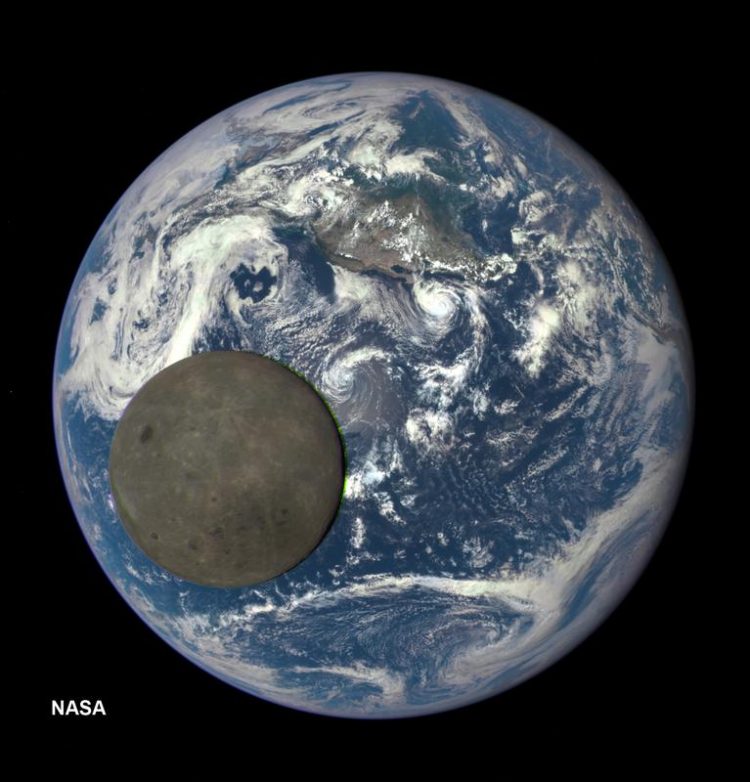Kiel University is going to fly behind the moon

NASA’s Earth Polychromatic Imaging Camera (EPIC) on board the NOAA’s Deep Space Climate Observatory (DSCOVR) satellite took this unique picture of the back of the moon in July 2015. Credit: NASA / DSCOVR by Earth Polychromatic Imaging Camera (EPIC)
“Kiel University is going to fly behind the moon!” said Jia Yu excitedly, a doctoral candidate at the Institute of Experimental and Applied Physics. Born in China, he will obtain his doctoral degree at Kiel University in a few months and then take over the project “Lunar Lander Neutron Dosimetry“ (LND).
“We weren't sure if we would be able to implement a project like this one from Kiel with our colleagues at the National Space Science Center in Beijing”, Yu reported. For this reason all those involved are even happier that it worked out.
Now that the decision has been made, the team, led by Professor Robert Wimmer-Schweingruber, faces a major task. Within one year, the physicists in Kiel want to develop, build and mount the new LND experiment on the spaceship. In the final quarter of 2018, this should then fly to the moon. “A real challenge”, said Lars Seimetz and Björn Schuster, the responsible mechanical and electronics engineers, “but really exciting. We can improve our designs that we developed for previous space missions.”
Radiation measuring instruments from Kiel have been used before in space missions by the American and European space agencies NASA and ESA: On board the Mars Rover “Curiosity”, the team is currently collecting data on galactic and solar particle radiation and using it to research the potential radiation exposure for manned missions to Mars.
The Kiel-based researchers provided four sensors for the “Solar Orbiter” space probe, which will also depart for space at the end of 2018 to research the sun. These sensors are to measure the spread and acceleration of solar particles. Successful experiments such as this one enabled the physicists to collect valuable experience which will be very useful when developing the LND.
The fourth Chinese mission to the moon aims to land on the side of the moon facing away from the Earth. The scientific data from the Lander and the Rover, which will then accommodate further experiments by international research teams, should then be sent to Earth via a relay satellite.
The Kiel-based experiment will measure radiation on the moon in preparation for future manned missions to the moon and – if all goes well – also measure the water content of the ground beneath the landing unit.
“To do this, we will be using a new technology developed for space to provide evidence of so-called thermal neutrons”, said Wimmer-Schweingruber. The physicist is convinced that everything will be ready on time, because the group is just right: “It is incredible to be working with such a great team!” This mission also continues a long-term cooperation with the Institute of Aerospace Medicine at the German Aerospace Center (DLR).
Contact:
Prof. Robert Wimmer-Schweingruber
Institute of Experimental and Applied Physics
E-Mail: wimmer@physik.uni-kiel.de
Tel.: +49 (0)173/9513332
http://www.uni-kiel.de/pressemeldungen/index.php?pmid=2016-106-mondmission&l…
Media Contact
All latest news from the category: Physics and Astronomy
This area deals with the fundamental laws and building blocks of nature and how they interact, the properties and the behavior of matter, and research into space and time and their structures.
innovations-report provides in-depth reports and articles on subjects such as astrophysics, laser technologies, nuclear, quantum, particle and solid-state physics, nanotechnologies, planetary research and findings (Mars, Venus) and developments related to the Hubble Telescope.
Newest articles

High-energy-density aqueous battery based on halogen multi-electron transfer
Traditional non-aqueous lithium-ion batteries have a high energy density, but their safety is compromised due to the flammable organic electrolytes they utilize. Aqueous batteries use water as the solvent for…

First-ever combined heart pump and pig kidney transplant
…gives new hope to patient with terminal illness. Surgeons at NYU Langone Health performed the first-ever combined mechanical heart pump and gene-edited pig kidney transplant surgery in a 54-year-old woman…

Biophysics: Testing how well biomarkers work
LMU researchers have developed a method to determine how reliably target proteins can be labeled using super-resolution fluorescence microscopy. Modern microscopy techniques make it possible to examine the inner workings…





















